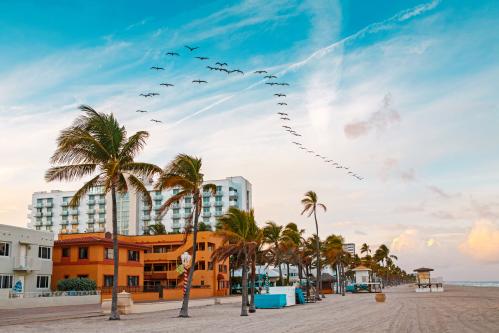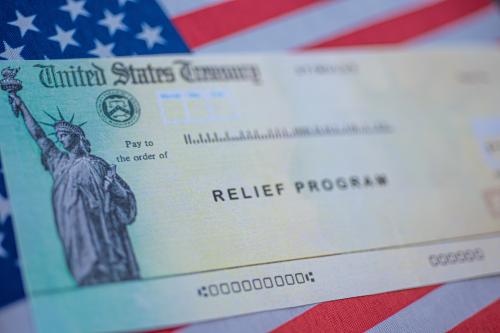In recent years, tensions between many U.S. cities and the states that house them have intensified amid rising political polarization. States have become increasingly “red,” with Republicans now safely commanding full control of 23 states while Democrats control only 15. By contrast, cities have become more “blue,” with the vast majority of mayors being Democrats. Of the nation’s 100 largest cities, Republicans lead only 26.
The Biden administration’s COVID-19 relief bill—the American Rescue Plan Act (ARP)—could help mend this divide. The act presents an opportunity to forge bipartisan investment agendas between cities and states that can aid residents, drive economic renewal, and engender lasting policy realignment.
Tensions between blue cities and red states frequently result in direct conflict. At least 40 states have prevented cities from establishing local gun ordinances; 28 states have prevented cities from enacting higher minimum wages; 23 states have prevented cities from implementing paid family leave; and at least five states have preempted cities’ plastic bag bans. Most recently, decisions around COVID-19 restrictions and mask requirements prompted city-state clashes with breathtaking speed and variety. A recent survey found that nearly 75% of mayors and 68% of health officials indicated that state preemption affects their local policymaking.
A successful recovery and renewal will require a new era of city-state relations, marked by cooperation, not conflict. This piece offers ideas for how ARP funds could be used as a creative starting point to increase city-state collaboration.
Unlike many recent fiscal aid packages, ARP directs $150 billion (or about 8% of the recovery effort) to cities and counties through block grants. Because ARP has minimal functional restrictions, cities can use this funding to shore up municipal balance sheets, respond to immediate pandemic-related needs, or invest in creative and strategic initiatives for more inclusive long-term growth. However, many localities struggle with policy and resource barriers that they have little control over, such as antiquated, state-run data and reporting systems. States can work with cities to identify priority investments or changes that would facilitate more effective program alignment and partnership.
One policy area that has potential for city-state collaboration through ARP is health care. ARP provides the 12 states that have not expanded Medicaid to their uninsured populations with an incentive to do so. According to the Kaiser Family Foundation, those incentives could total nearly $9.6 billion for Medicaid expansion, insuring over 4 million residents in the wake of a pandemic that has unveiled a broken health care infrastructure.
However, even with the incentives, many governors and state legislators are wrestling with how to pay the startup costs associated with expanding Medicaid—estimated at $6.8 billion across the 12 states. The majority of people who would gain health coverage from Medicaid expansion live in metro areas; so, since cities benefit most from the expansion, they could use a fixed percentage of their ARP funds to help states offset those startup costs.
For example, if the five largest cities in Alabama collectively chipped in 5% of their respective ARP allocations, they would cut the state’s Medicaid expansion startup costs by about 8%. Not only would city residents gain health coverage, city health care providers would reduce losses associated with uncompensated medical care. If states still refuse to expand, then the Biden administration could push to amend the law to accept local waivers for Medicaid expansion without state support, so that metro areas could expand Medicaid in their region.
Another area for potential city-state collaboration is the development of a fund for small and medium-sized enterprises (SMEs) to invest in talent development to spur an inclusive recovery. Cities have large populations of talent with great potential but low access to a traditional college degree or who struggle with employment barriers such as child care, transportation, or involvement in the justice system. An equitable, inclusive recovery will need to offer more opportunities (such as earn-and-learn models) for working adults to get a job that pays a family-sustaining wage.
However, employers—especially SMEs that struggle to find resources for staff development—tend to underinvest in training. Recent evidence from California found that state reimbursements for training SME employees had significant and large returns on both jobs and revenue. Pairing these incentives with business accelerators that target women-, Black-, Latino- or Hispanic-, and veteran-owned SMEs may also generate homegrown economic development and local wealth in historically disenfranchised communities, which COVID-19 hurt worst.
Cities and states can use ARP funds to embolden SMEs to invest in their workers and adopt new technologies. Similar to manufacturing extension programs (but for a wider range of industry sectors), cities and states can partner with industry associations to establish a pool of funds that SMEs can access for grants (or low-interest loans) to upgrade their training and production capacity. These upgrades can include purchasing learning management systems, offering managerial or supervisory trainings, providing trainings on new software or equipment, or funding startup costs for apprenticeships.
The funds can also be used to seed partnerships between community colleges, public universities, workforce boards, and small business development centers to offer modularized courses designed to meet the needs of small businesses and working adult learners. By leveraging ARP funds as shared investments in training and business development, they can serve as a “public option” for firms that couldn’t otherwise afford targeted training and staff development programs. ARP loan funds could initially be structured as pilot grants, but if they are successful, cities and states could work together to capitalize revolving loan funds when ARP expires. The role of the state versus the city may vary based on states’ existing institutional setup for training and education, with some states opting for centralized programs and others more decentralized.
In an increasingly polarized political climate, blue cities in red states are at the fault lines of American democracy. But cities and states should be economic development allies, not adversaries. Aligning city and state ARP funds to advance shared priorities could not only accelerate the pace and extend the reach of innovation and economic recovery—it may also begin a new era of democratic renewal.
The Brookings Institution is committed to quality, independence, and impact.
We are supported by a diverse array of funders. In line with our values and policies, each Brookings publication represents the sole views of its author(s).









Commentary
Blue cities and red states need to work together to rebuild after COVID-19
April 23, 2021